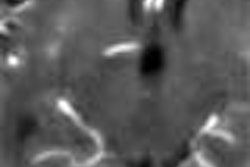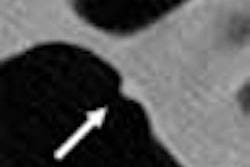Results from a recent study show that 18FDG-PET studies are highly accurate in detecting the spread of colon cancer, and should be used for the staging or restaging of patients with the disease. The study also found that PET scans are very useful for evaluating patients with recurrent colon cancer.
Dr. Imtiaz Ahmed discussed his group's work on the efficacy of whole-body FDG-PET imaging, compared with conventional CT, in imaging colon cancer patients at the 2003 American Roentgen Ray Society meeting in San Diego. Ahmed and colleagues are from Hahneman University Hospital and Mercy Catholic Medical Center in Philadelphia.
"Based on our results, 18FDG-PET was almost twice as sensitive as CT in detecting the spread of colon cancer," Ahmed said.
The team examined 35 patients ranging in age from 40 to 83 (mean 60) years, who had various stages of proven colon carcinoma. The patients underwent 39 sets of PET and CT studies. All CT imaging was performed with contrast.
Whole-body FDG-PET imaging was performed on all the patients after the CT studies were conducted. The PET scans were done 45-60 minutes following intravenous injection of an average dose of 5.6 mCi of 18FDG.
The researchers then performed radiographic and pathologic correlations on each patient’s studies. When the team compared the FDG-PET studies with the CT exams, they found a sensitivity of 89% for PET and 50% for CT.
"The PET scans were clearly better than CT imaging for staging colon cancer," Ahmed said.
This was demonstrated by an overall specificity of 91% for PET compared with 73% for CT; accuracy of 90% compared with 56%; a positive predictive value of 96% compared with 82%; and a negative predictive value of 77% compared with 36%, respectively, Ahmed reported.
In addition to superior performance, PET also had other advantages over CT, according to Ahmed. "Radiation exposure can be lower than CT, because CT examinations may require multiple scans. Also, because one PET scan can produce the same -- or better -- results as multiple CT scans, PET may also end up being more cost effective than CT," he said.
Ahmed recommended that when available, FDG-PET be used instead of CT for the staging of patients with suspected cancer spread, restaging of patients who have already been treated for cancer, and for the evaluation of patients with rising carcinoembryonic antigen levels as a tumor marker for recurrent colon cancer.
CT imaging still has its place in colon cancer treatment, as well as treatment of other soft-tissue carcinomas.
"Although 18FDG-PET scans are significantly better than CT in staging, restaging, and evaluating colon carcinoma at various stages, conventional CT imaging, which is able to detect anatomical features, must be done during initial staging to localize the tumor site as a guide for surgery," Ahmed said.
By Jonathan S. BatchelorAuntMinnie.com staff writer
May 23, 2003
Related Reading
PET/CT boosts confidence in rectal cancer staging, US yields high sensitivity, April 3, 2003
Study gives MRI edge over CT, US in rectal cancer staging, March 7, 2003
Unexpected FDG-PET foci may signal subclinical tumors, December 26, 2002
FDG-PET signals early response of malignant GI tumors to Gleevec, July 1, 2002
Virtual colonoscopy falls short in multicenter trial, June 3, 2002
Copyright © 2003 AuntMinnie.com



















